Scaffolding Embodied Access for Categorization in Interactions between a Blind Child and Her Mother
Abstract
1. Introduction
1.1. A Multimodal, Interactional Perspective
1.2. Beyond the Visual
2. Materials and Methods
3. Results
- During the play activity, how does Mother scaffold multimodal routines for the identification of criterial information about a category?
- How is knowledge of varied exemplars, not directly accessible within the current activity, then made available to the child?
3.1. Orienting to What It Criterial
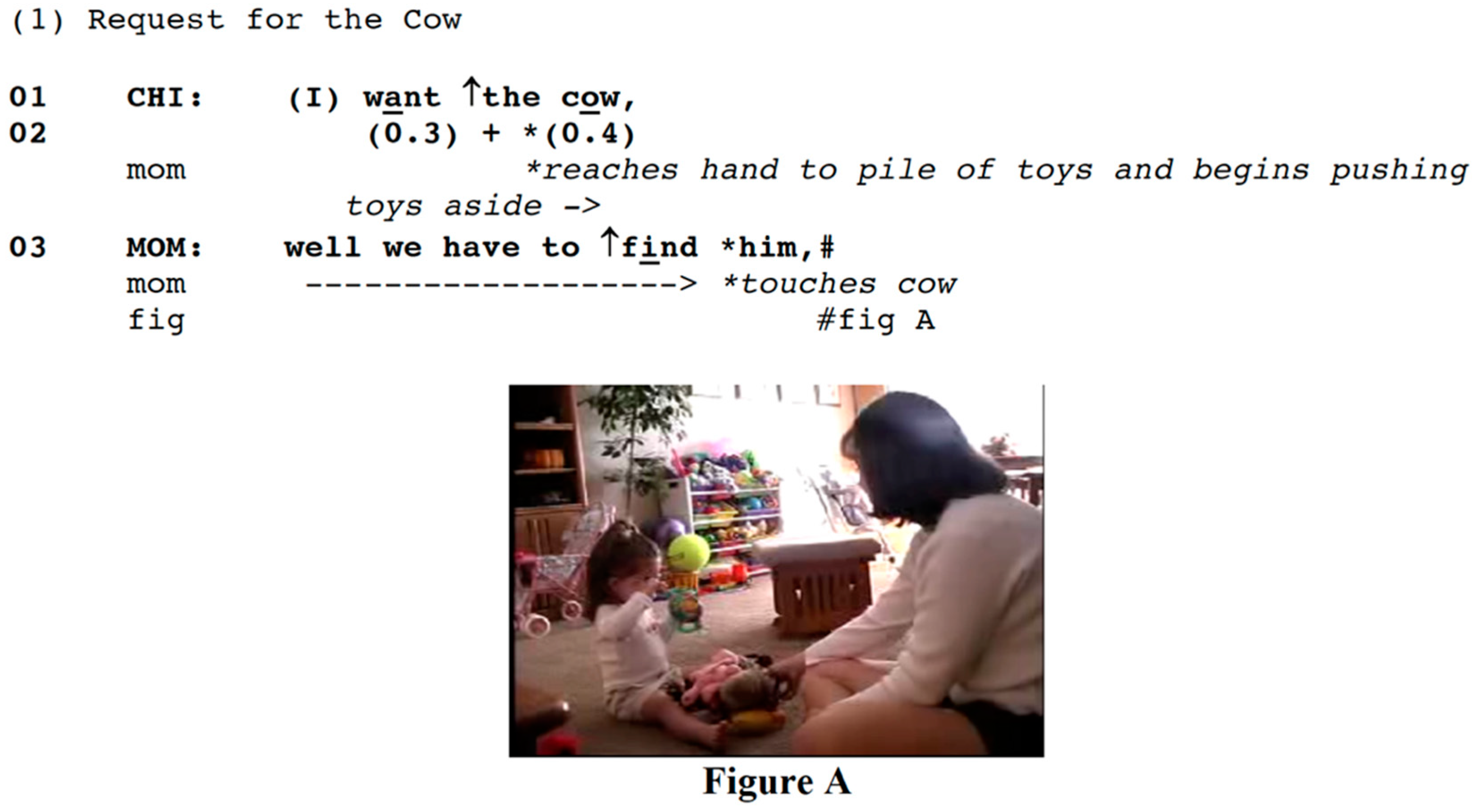
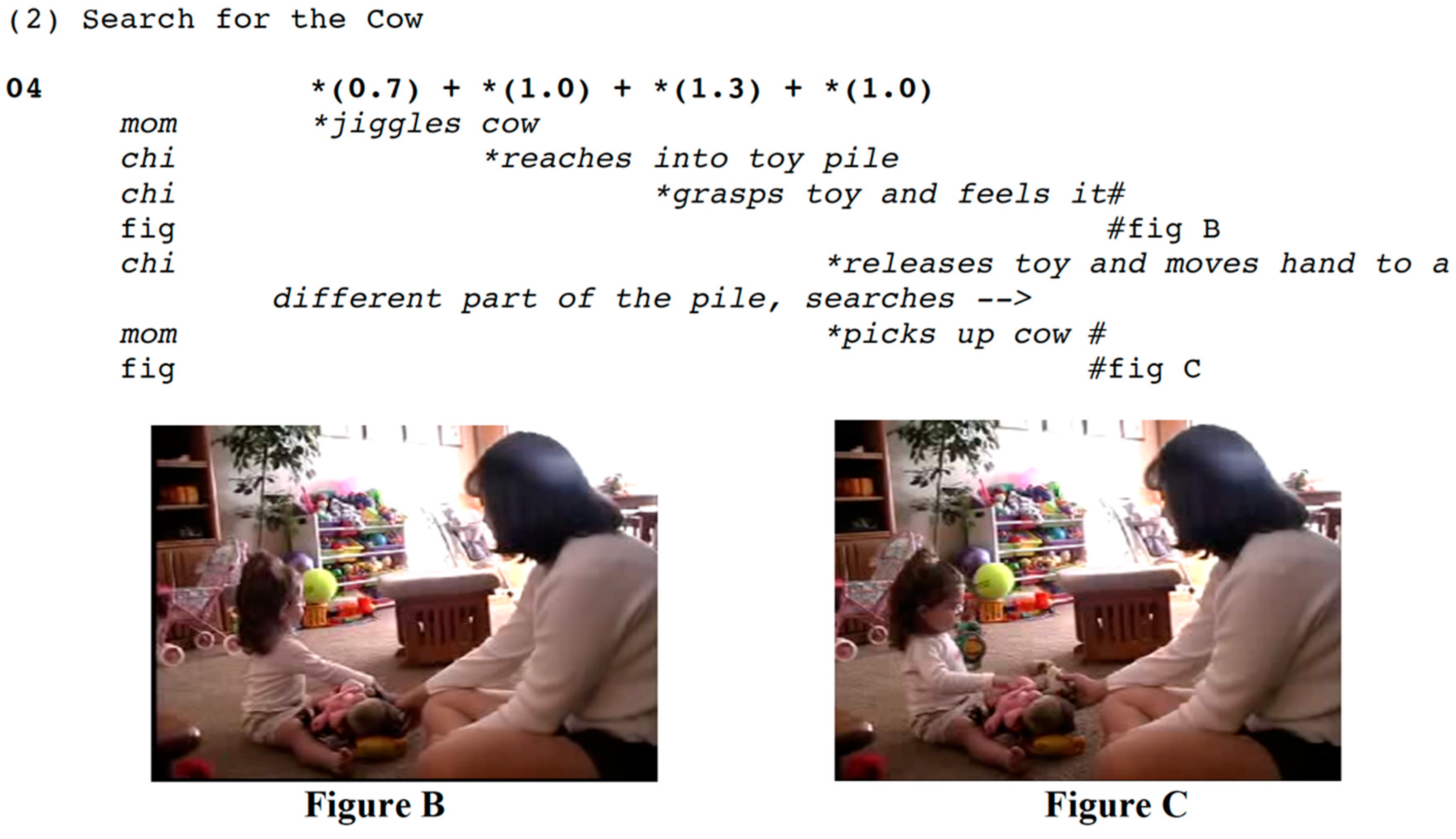
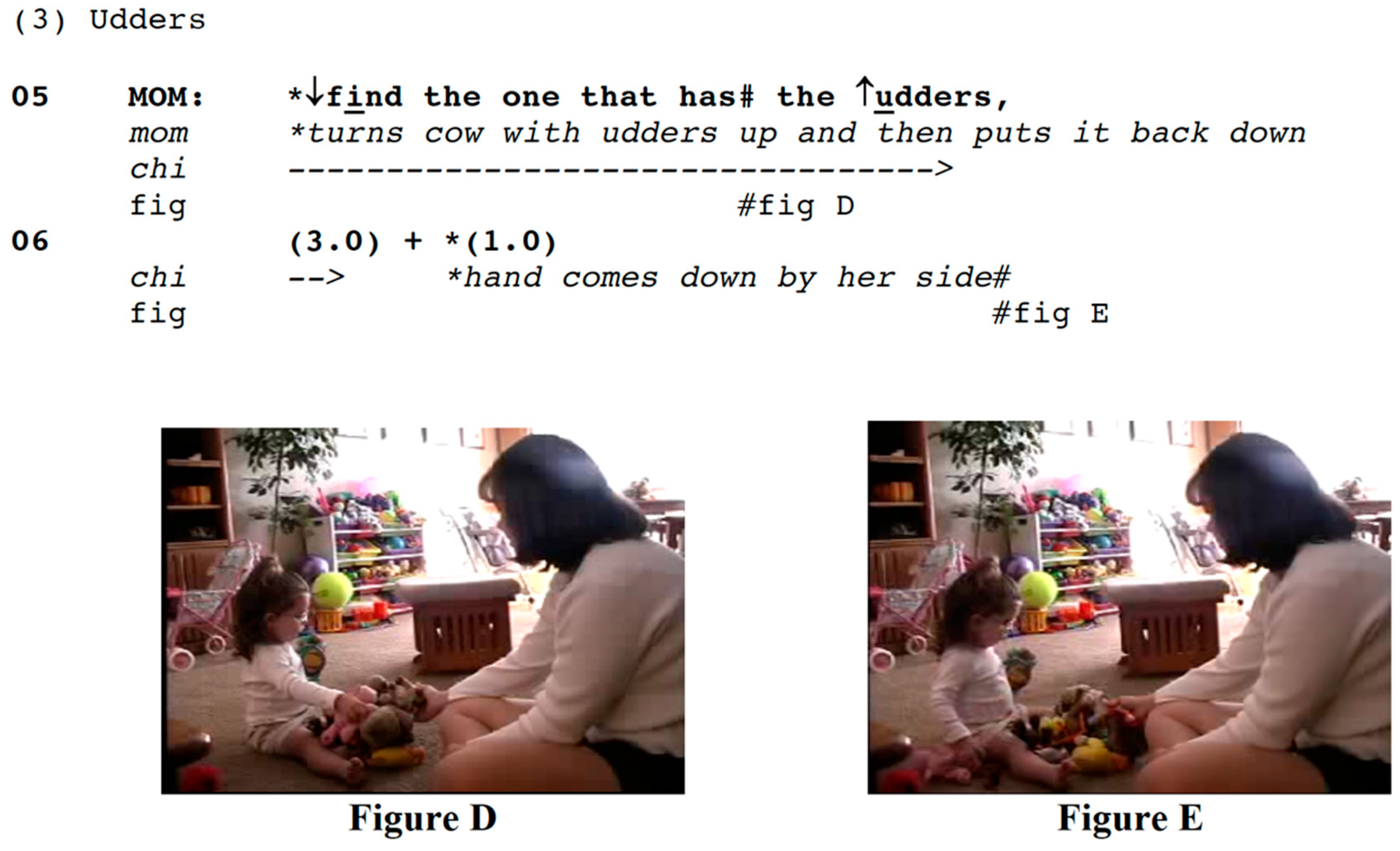
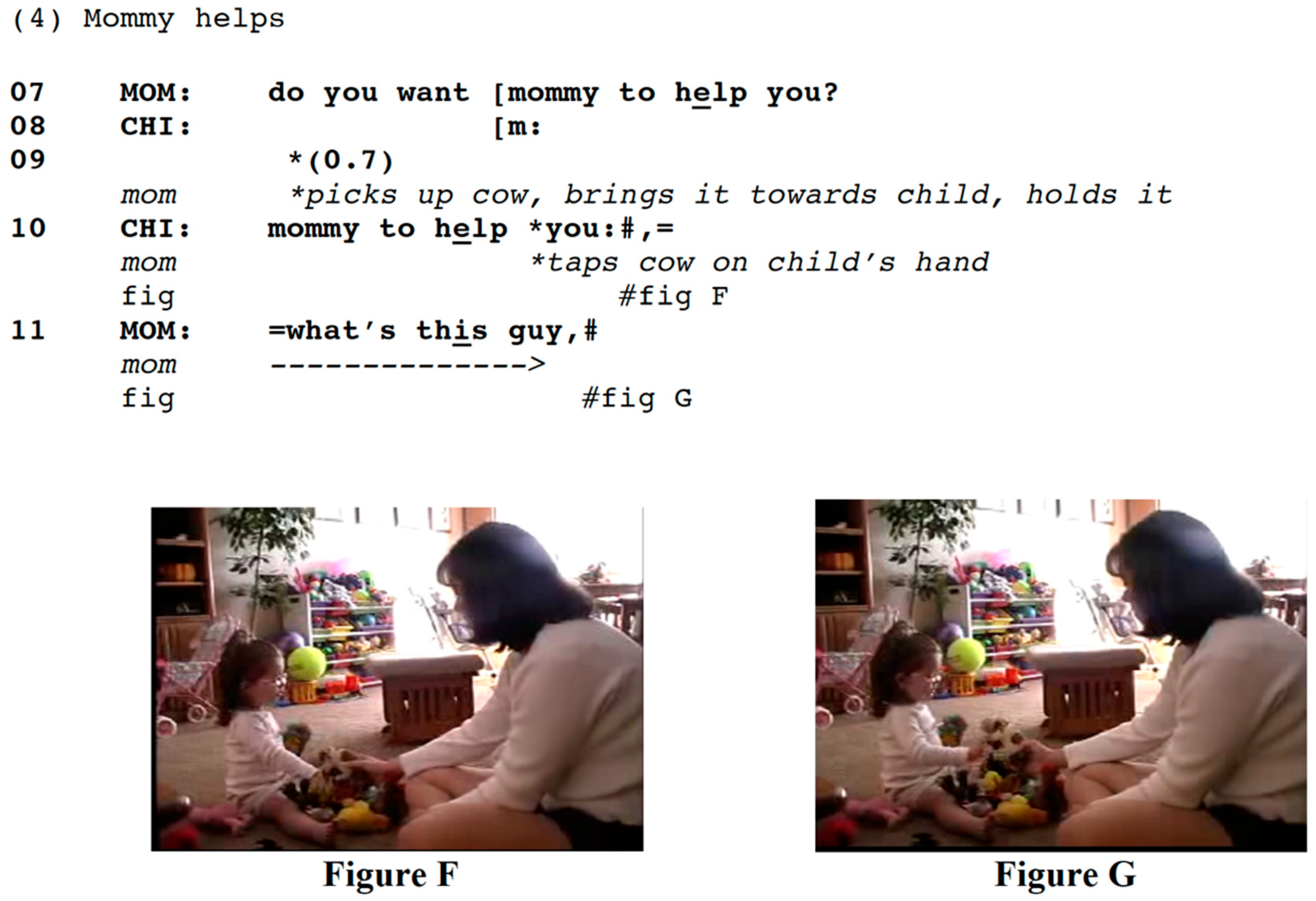
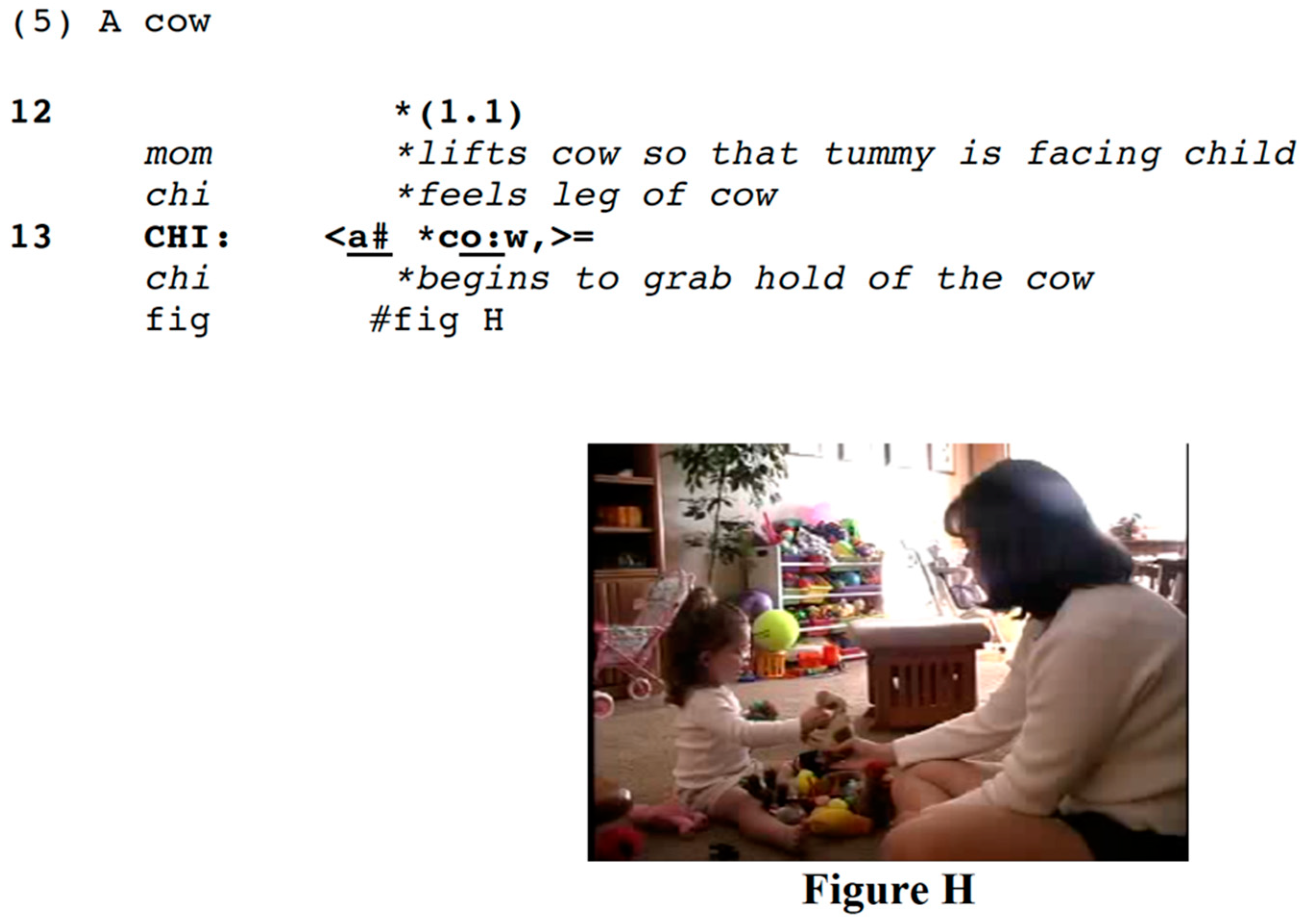
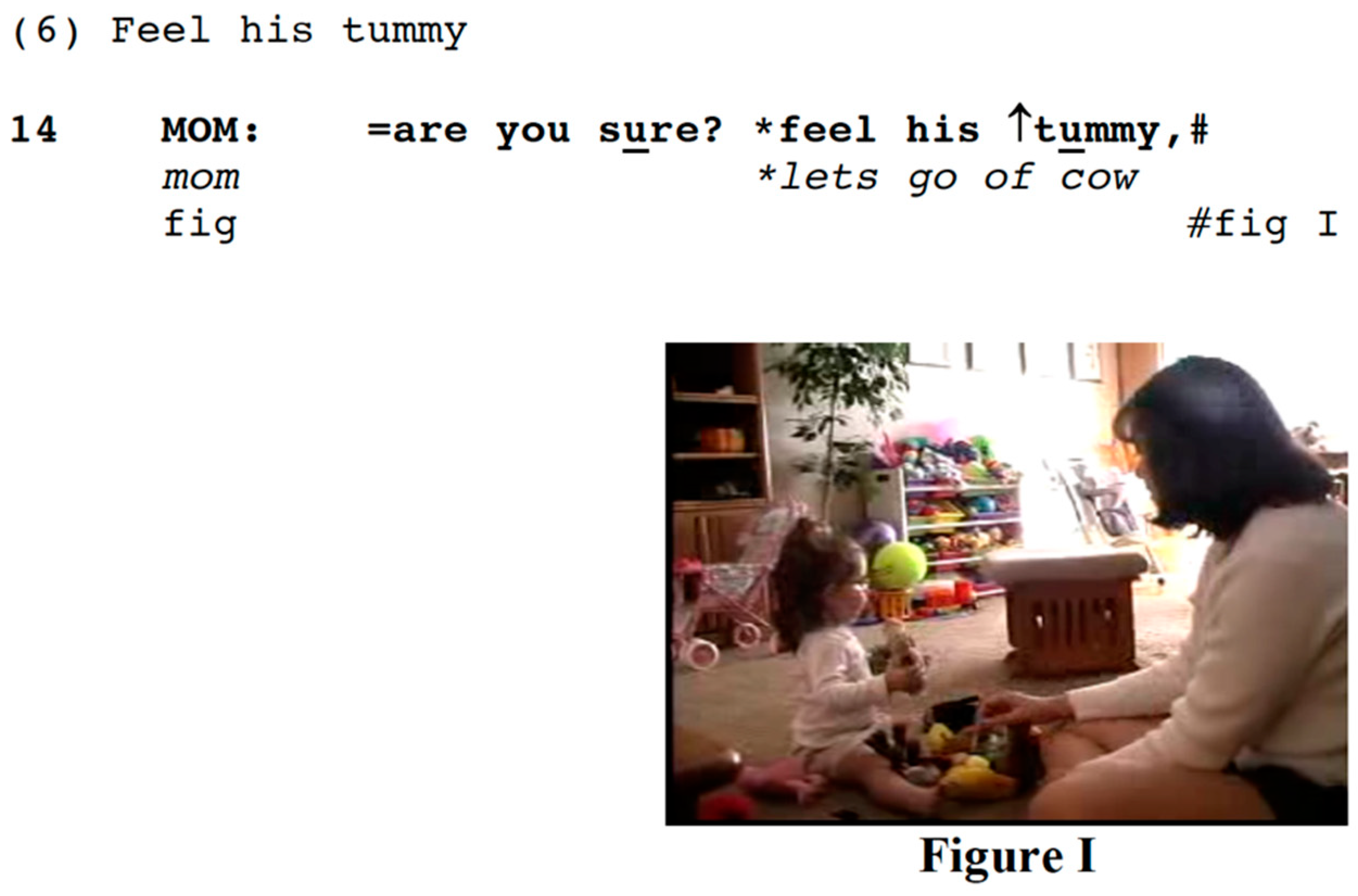
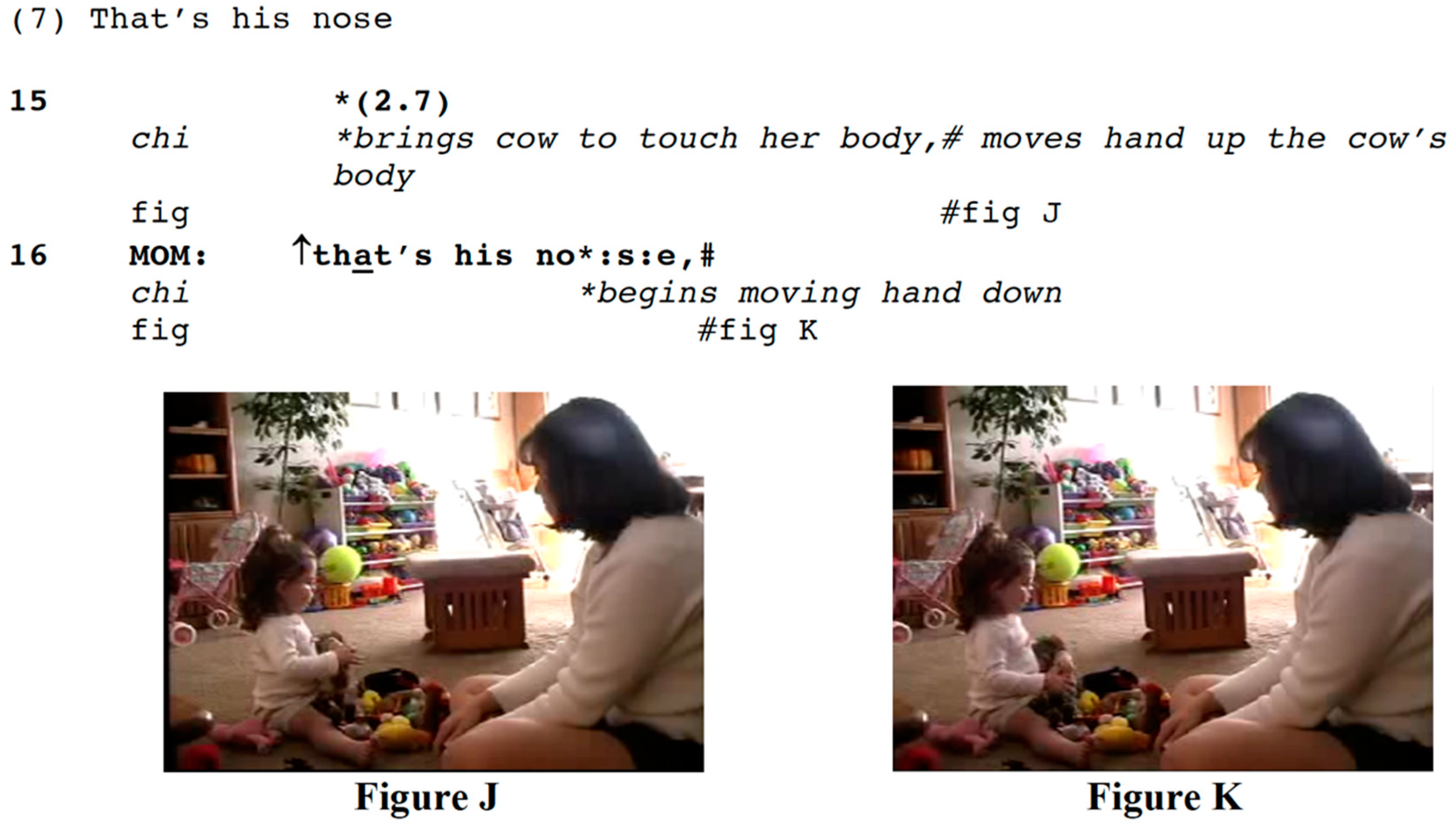
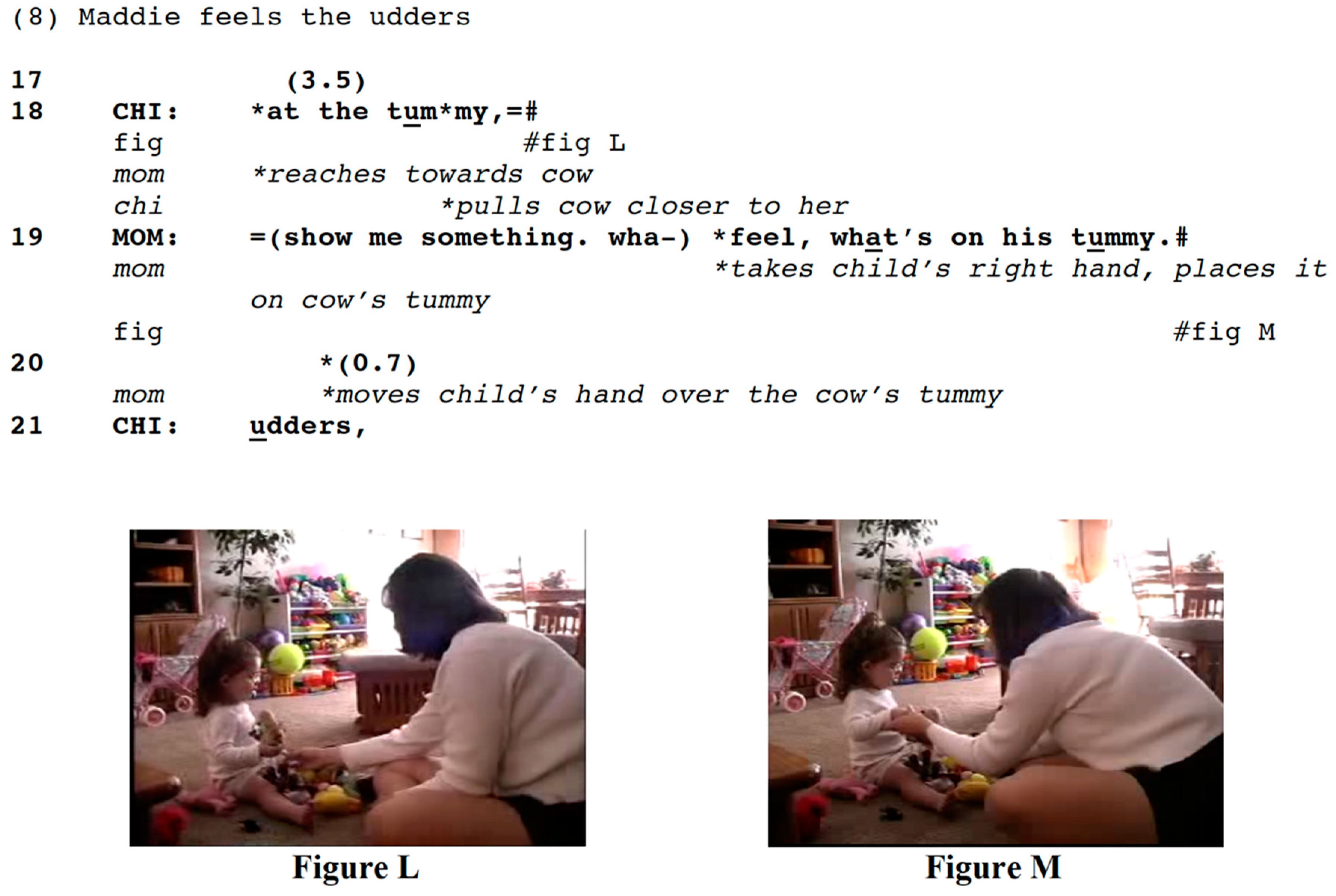
3.2. Orienting to Varied Exemplars
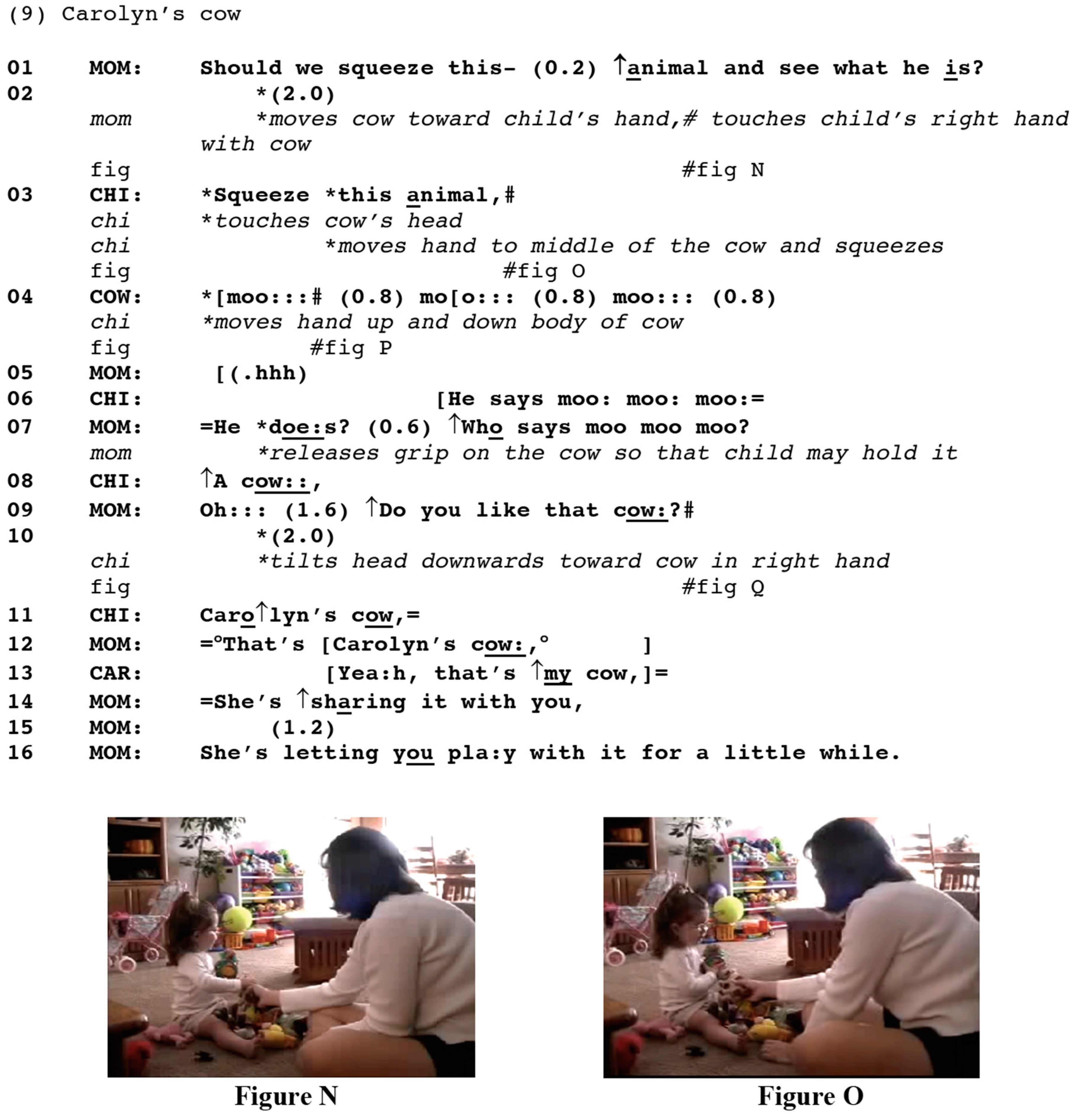
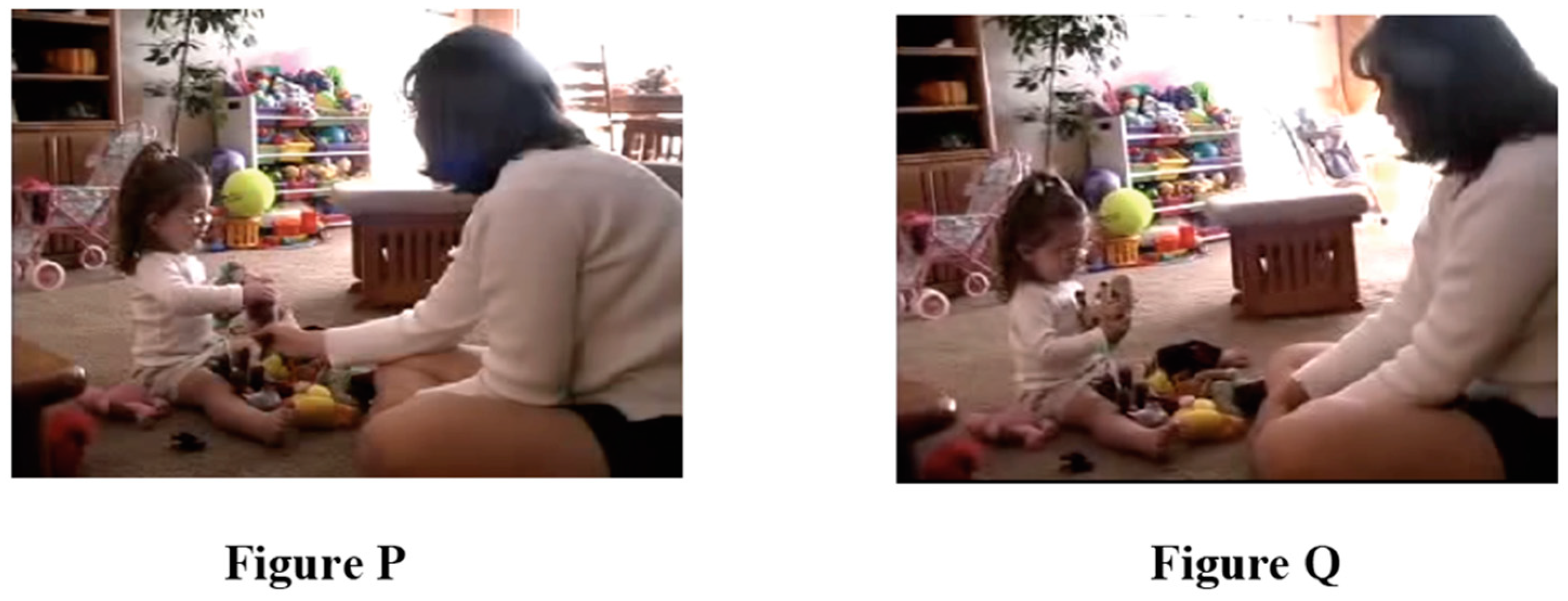
4. Discussion and Conclusions
Author Contributions
Funding
Acknowledgments
Conflicts of Interest
References
- Akhtar, Nameera, and Morton Ann Gernsbacher. 2008. On privileging the role of gaze in infant social cognition. Child Development Perspectives 2: 59–65. [Google Scholar] [CrossRef] [PubMed]
- Akhtar, Nameera, and Michael Tomasello. 2000. The social nature of words and word learning. In Becoming a Word Learner: A Debate on Lexical Acquisition. Edited by Roberta Micknick Golinkoff and Kathryn Hirsh-Pasek. New York: Oxford University Press, pp. 115–35. [Google Scholar]
- Andersen, Elaine S., Anne Dunlea, and Linda Kekelis. 1993. The impact of input: Language acquisition in the visually impaired. First Language 13: 23–49. [Google Scholar] [CrossRef]
- Avital, Sharon, and Jurgen Streeck. 2011. Terra Incognita: Social interaction among blind children. In Embodied Interaction: Language and Body in the Material World. Edited by Jürgen Streeck, Charles Goodwin and Curtis LeBaron. Cambridge: Cambridge University Press, pp. 169–81. [Google Scholar]
- Barsalou, Lawrence W. 1999. Perceptual symbol systems. Behavioral and Brain Sciences 22: 577–660. [Google Scholar] [CrossRef] [PubMed]
- Borghi, Anna M. 2005. Object concepts and action. In Grounding Cognition: The Role of Perception and Action in Memory, Language, and Thinking. Edited by Diane Pecher and Rolf A. Zwaan. New York: Cambridge University Press, pp. 8–34. [Google Scholar]
- Bruner, Jerome S. 1975. From communication to language: A psychological perspective. Cognition 3: 255–87. [Google Scholar] [CrossRef]
- Church, R. Breckinridge, and Susan Goldin-Meadow. 1986. The mismatch between gesture and speech as an index of transitional knowledge. Cognition 23: 43–71. [Google Scholar] [CrossRef]
- Clark, Herbert H. 2003. Pointing and placing. In Pointing: Where Language, Culture and Cognition Meet. Edited by Sotaro Kita. Hillsdale: Erlbaum, pp. 243–68. [Google Scholar]
- Clift, Rebecca. 2016. Conversation Analysis. Cambridge: Cambridge University Press. [Google Scholar]
- Clift, Rebecca, and Chase Wesley Raymond. 2018. Actions in practice: On details in collections. Discourse Studies 20: 90–119. [Google Scholar] [CrossRef]
- de Vega, Manuel, Arthur M. Glenberg, and Arthur C. Graesser. 2008. Symbols and Embodiment: Debates on Meaning and Cognition. New York: Oxford University Press. [Google Scholar]
- Edelman, Gerald M. 1992. Bright Air, Brilliant Fire: On the Matter of the Mind. New York: Basic Books. [Google Scholar]
- Gibson, James J. 1979. The Ecological Approach to Visual Perception. Boston: Houghton Mifflin. [Google Scholar]
- Goldin-Meadow, Susan. 2003. Hearing Gesture: How Our Hands Help Us Think. Cambridge: Belknap Press of Harvard University Press. [Google Scholar]
- Golinkoff, Roberta Michnick, Carolyn B. Mervis, and Kathryn Hirsh-Pasek. 1994. Early object labels: The case for a developmental lexical principles framework. Journal of Child Language 21: 125–55. [Google Scholar] [CrossRef] [PubMed]
- Goodwin, Charles. 2000. Action and embodiment within situated human interaction. Journal of Pragmatics 32: 1489–522. [Google Scholar] [CrossRef]
- Goodwin, Charles. 2018. Co-Operative Action. New York: Cambridge University Press. [Google Scholar]
- Goodwin, Marjorie Harness, and Asta Cekaite. 2018. Embodied Family Choreography: Practices of Control, Care, and Mundane Creativity. New York: Routledge. [Google Scholar]
- Haith, Marshall M., and Janette B. Benson. 1998. Infant Cognition. In Handbook of Child Psychology. Edited by William Damon, Deanna Khun and Robert Siegler. New York: John Wiley & Sons, pp. 199–254. [Google Scholar]
- Kendon, Adam. 2004. Gesture: Visible Action Utterance. Cambridge: Cambridge University Press. [Google Scholar]
- Langton, Stephen R. H., Roger J. Watt, and Vicki Bruce. 2000. Do the eyes have it: Cues to the direction of social attention. Trends in Cognitive Science 4: 50–59. [Google Scholar] [CrossRef]
- Mondada, Lorenza. 2018. Multiple temporalities of language and body in interaction: Challenges for transcribing multimodality. Research on Language & Social Interaction 51: 85–106. [Google Scholar]
- Nelson, Katherine. 1996. Language in Cognitive Development: The Emergence of the Mediated Mind. Cambridge: Cambridge University Press. [Google Scholar]
- Noe, Alva. 2004. Action in Perception. Cambridge: MIT Press. [Google Scholar]
- Ozcaliskan, Şeyda, and Susan Goldin-Meadow. 2005. Do parents lead their children by the hand? Journal of Child Language 32: 481–505. [Google Scholar] [CrossRef] [PubMed]
- Pecher, Diane, and Rolf A. Zwaan, eds. 2005. Introduction to Grounding Cognition: The role of perception and action in memory, language, and thinking. In Grounding Cognition: The Role of Perception and Action in Memory, Language, and Thinking. New York: Cambridge University Press, pp. 1–7. [Google Scholar]
- Perez-Pereira, Miguel, and Gina Conti-Ramsden. 1999. Language Development and Social Interaction in Blind Children. East Sussex: Psychology Press. [Google Scholar]
- Rickard, Carolyn. 2013. Multimodal Cues in the Socialization of Joint Attention in Young Children with Varying Degrees of Vision: Getting the POINT Even When You Can’t See It. Ph.D. dissertation, University of Colorado, Boulder, CO, USA. [Google Scholar]
- Schegloff, Emanuel A. 1987. Analyzing single episodes of interaction: An exercise in conversation analysis. Social Psychology Quarterly 50: 101–14. [Google Scholar] [CrossRef]
- Schegloff, Emanuel A. 2007. Sequence Organization: A Primer in Conversation Analysis (Vol. 1). Cambridge: Cambridge University Press. [Google Scholar]
- Semin, Gün R., and John T. Cacioppo. 2008. Grounding social cognition: Synchronization, coordination, and co-regulation. In Embodied Grounding: Social, Cognitive, Affective, and Neuroscientific Approaches. Edited by Gün R. Semin and Eliot R. Smith. New York: Cambridge University Press, pp. 119–47. [Google Scholar]
- Semin, Gün R., and Eliot R. Smith. 2008. Embodied Grounding: Social, Cognitive, Affective, and Neuroscientific Approaches. New York: Cambridge University Press. [Google Scholar]
- Smith, Linda B., and Larissa K. Samuelson. 1997. Perceiving and Remembering: Category Stability, Variability, and Development. In Knowledge, Concepts, and Categories. Edited by Koen Lamberts and David R. Shanks. Hove: Psychology Press, pp. 161–95. [Google Scholar]
- Streeck, Jurgen, Charles Goodwin, and Curtis LeBaron. 2011. Embodied Interaction: Language and Body in the Material World. Cambridge: Cambridge University Press. [Google Scholar]
- Struiksma, Marijn E., Matthijs L. Noordzij, and Albert Postma. 2009. What is the link between language and spatial images? Behavioral and neural findings in blind and sighted individuals. Acta Psychologica 132: 145–56. [Google Scholar] [CrossRef] [PubMed]
- Tomasello, Michael. 2003. Constructing a Language: A Usage-Based Theory of Language Acquisition. Cambridge: Harvard University Press. [Google Scholar]
- Vigliocco, Gabriella, Pamela Perniss, and David Vinson. 2014. Language as a multimodal phenomenon: Implications for language learning, processing and evolution. Philosophical Transactions of the Royal Society B 369: 20130292. [Google Scholar] [CrossRef] [PubMed]
- Vygotsky, Lev Semenovich. 1978. Mind in Society: The Development of Higher Psychological Processes. Cambridge: Harvard University Press. [Google Scholar]
- Wilson, Margaret. 2002. Six views of embodied cognition. Psychonomic Bulletin and Review 9: 625–36. [Google Scholar] [CrossRef] [PubMed]
- Zukow-Goldring, Patricia, and Kelly R. Ferko. 1994. An ecological approach to the emergence of the lexicon: Socializing attention. In Sociocultural Approaches to Language and Literacy: An Interactionist Perspective. Edited by Vera John-Steiner, Carolyn P. Panofsky and Larry W. Smith. New York: Cambridge University Press, pp. 170–90. [Google Scholar]
| 1 | |
| 2 | In addition, Mother’s use of the proximal deictic this form very recently in the interaction (line 1) may cause some confusion for Maddie, who herself repeated the proximal form in line 3. |
© 2019 by the authors. Licensee MDPI, Basel, Switzerland. This article is an open access article distributed under the terms and conditions of the Creative Commons Attribution (CC BY) license (http://creativecommons.org/licenses/by/4.0/).
Share and Cite
Rickard, C.; Strother, M.; Fox, B.A.; Raymond, C.W. Scaffolding Embodied Access for Categorization in Interactions between a Blind Child and Her Mother. Languages 2019, 4, 2. https://doi.org/10.3390/languages4010002
Rickard C, Strother M, Fox BA, Raymond CW. Scaffolding Embodied Access for Categorization in Interactions between a Blind Child and Her Mother. Languages. 2019; 4(1):2. https://doi.org/10.3390/languages4010002
Chicago/Turabian StyleRickard, Carolyn, Mara Strother, Barbara A. Fox, and Chase Wesley Raymond. 2019. "Scaffolding Embodied Access for Categorization in Interactions between a Blind Child and Her Mother" Languages 4, no. 1: 2. https://doi.org/10.3390/languages4010002
APA StyleRickard, C., Strother, M., Fox, B. A., & Raymond, C. W. (2019). Scaffolding Embodied Access for Categorization in Interactions between a Blind Child and Her Mother. Languages, 4(1), 2. https://doi.org/10.3390/languages4010002




